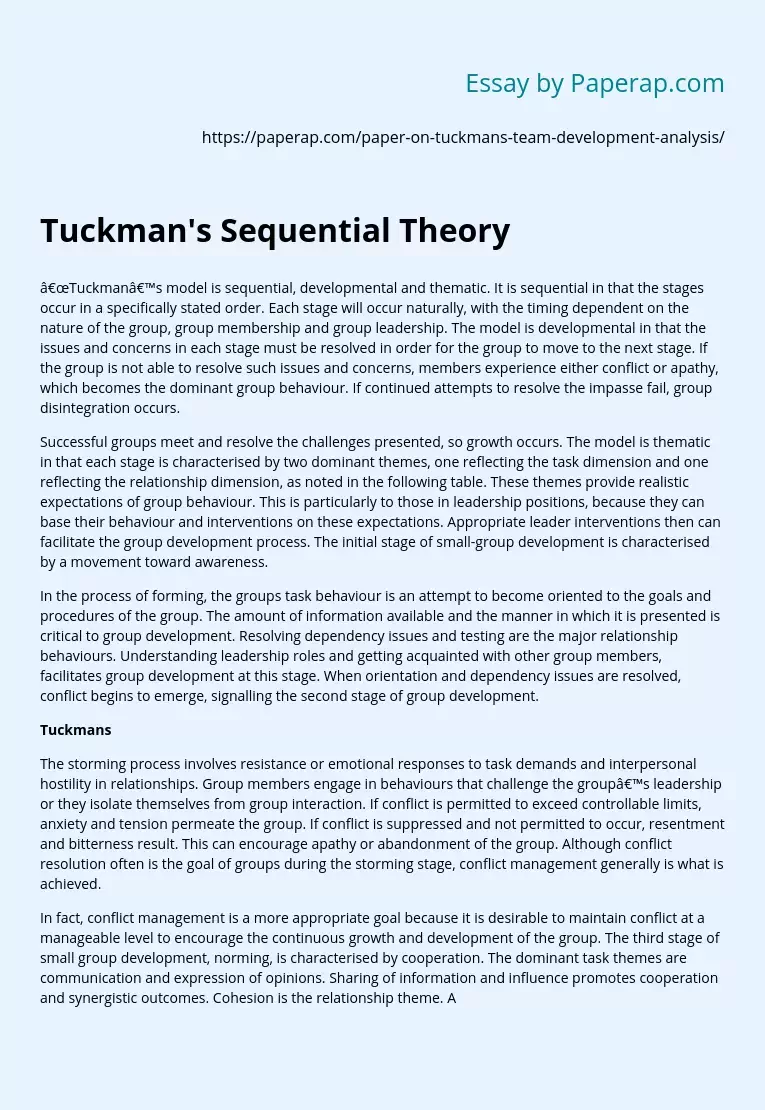Tuckman's Sequential Theory
“Tuckman’s model is sequential, developmental and thematic. It is sequential in that the stages occur in a specifically stated order. Each stage will occur naturally, with the timing dependent on the nature of the group, group membership and group leadership. The model is developmental in that the issues and concerns in each stage must be resolved in order for the group to move to the next stage. If the group is not able to resolve such issues and concerns, members experience either conflict or apathy, which becomes the dominant group behaviour.
If continued attempts to resolve the impasse fail, group disintegration occurs.
Successful groups meet and resolve the challenges presented, so growth occurs. The model is thematic in that each stage is characterised by two dominant themes, one reflecting the task dimension and one reflecting the relationship dimension, as noted in the following table. These themes provide realistic expectations of group behaviour. This is particularly to those in leadership positions, because they can base their behaviour and interventions on these expectations.
Appropriate leader interventions then can facilitate the group development process. The initial stage of small-group development is characterised by a movement toward awareness.
In the process of forming, the groups task behaviour is an attempt to become oriented to the goals and procedures of the group. The amount of information available and the manner in which it is presented is critical to group development. Resolving dependency issues and testing are the major relationship behaviours. Understanding leadership roles and getting acquainted with other group members, facilitates group development at this stage.
When orientation and dependency issues are resolved, conflict begins to emerge, signalling the second stage of group development.
Tuckmans
The storming process involves resistance or emotional responses to task demands and interpersonal hostility in relationships. Group members engage in behaviours that challenge the group’s leadership or they isolate themselves from group interaction. If conflict is permitted to exceed controllable limits, anxiety and tension permeate the group. If conflict is suppressed and not permitted to occur, resentment and bitterness result. This can encourage apathy or abandonment of the group. Although conflict resolution often is the goal of groups during the storming stage, conflict management generally is what is achieved.
In fact, conflict management is a more appropriate goal because it is desirable to maintain conflict at a manageable level to encourage the continuous growth and development of the group. The third stage of small group development, norming, is characterised by cooperation. The dominant task themes are communication and expression of opinions. Sharing of information and influence promotes cooperation and synergistic outcomes. Cohesion is the relationship theme. A blend of harmony and openness is created by the work effort, which increases morale and team building efforts.
Group unity develops, and shared responsibilities increase, typically leading to decision making by consensus and democratic leadership styles. The fourth stage of small-group development is evidenced by productivity. Performing encourages functional role relatedness. The task theme is problem solving. Group effort is mobilised to achieve group goals. Group members provide valuable contributions by assuming appropriate roles that enhance problem solving. The relationship theme is interdependence; it is the basis for any successful team effort and it requires group members simultaneously to be highly independent and highly dependent.
The final stage of small-group development brings the group to an end. The adjourning process involves termination of task behaviours and disengagement from relationships. Conclusion of the group is not always planned. A planned group conclusion usually involves recognition for participation and achievement as well as an opportunity for members to say personal good-byes. Adjournment of the group should be accomplished within a set time frame and have a recognisable ending point. “
Tuckman's Sequential Theory. (2019, Dec 05). Retrieved from https://paperap.com/paper-on-tuckmans-team-development-analysis/

